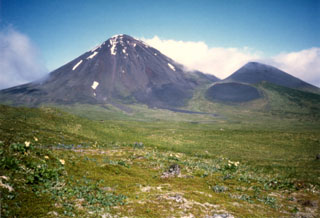Report on Semisopochnoi (United States) — 17 July-23 July 2019
Smithsonian Institution / US Geological Survey
Weekly Volcanic Activity Report, 17 July-23 July 2019
Managing Editor: Sally Sennert.
Please cite this report as:
Global Volcanism Program, 2019. Report on Semisopochnoi (United States) (Sennert, S, ed.). Weekly Volcanic Activity Report, 17 July-23 July 2019. Smithsonian Institution and US Geological Survey.
Semisopochnoi
United States
51.93°N, 179.58°E; summit elev. 1221 m
All times are local (unless otherwise noted)
AVO reported that data from local seismic and infrasound sensors likely detected a small explosion at Semisopochnoi on 16 July. No ash was visible in cloudy satellite images although none was expected from an explosion of its size. A small plume drifted 18 km from the vent but had no indication of ash. A strong tremor signal was recorded at 2339 on 17 July and an infrasound signal was detected from an array located 260 km E on Adak Island. The event likely produced ash emissions, though none were visible above the cloud deck at 3 km (10,000 ft) a.s.l. Seismic activity continued to increase. On 18 July a short-lived, low-level eruption prompted AVO to raise the Aviation Color Code to Orange (the second highest level on a four-color scale) and the Volcano Alert Level to Watch (the second highest level on a four-level scale). A low-level plume was visible in occasional cloud-free satellite images. Seismic activity decreased abruptly that night and ground-coupled airwaves stopped being detected on adjacent islands, suggesting that the eruption had paused or ended. Seismic activity remained low at least through 21 July.
Geological Summary. Semisopochnoi, the largest subaerial volcano of the western Aleutians, is 20 km wide at sea level and contains an 8-km-wide caldera. It formed as a result of collapse of a low-angle, dominantly basaltic volcano following the eruption of a large volume of dacitic pumice. The high point of the island is Anvil Peak, a double-peaked late-Pleistocene cone that forms much of the island's northern part. The three-peaked Mount Cerberus (renamed Mount Young in 2023) was constructed within the caldera during the Holocene. Each of the peaks contains a summit crater; lava flows on the N flank appear younger than those on the south side. Other post-caldera volcanoes include the symmetrical Sugarloaf Peak SSE of the caldera and Lakeshore Cone, a small cinder cone at the edge of Fenner Lake in the NE part of the caldera. Most documented eruptions have originated from Young, although Coats (1950) considered that both Sugarloaf and Lakeshore Cone could have been recently active.
Source: US Geological Survey Alaska Volcano Observatory (AVO)

